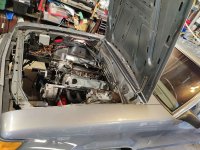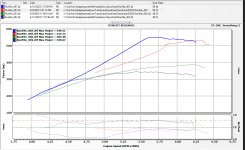I've had an opportunity to pull up my dyno session from the Whipple. We're only about 12 rwhp off the power level that got the car in the 9's. Of course, I did tweak it a bit over time, but we're right in the same ballpark. It also appears, but this is a bit harder to confirm, that we weren't pushing through the converter as hard.
I've been thinking about it, and the car was on the dyno for 4 hours and had 8 pulls in total. The whole time, the header collectors are about an inch away from the transmission pan on both sides, just cooking the fluid. Since there's really no airflow (Ray's fan is a bit anemic), that's likely the difference. We'll have to take it to the track and see what it does. Before with the Whipple, I had different (shorter) headers on the car and the pipes were not nearly as close to the transmission pan. On top of that, that was a different Dynojet that was only about 15 miles away, not 100.



